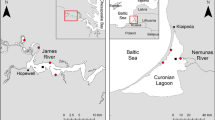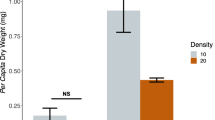Abstract
Fine particulate organic matter is a major food resource in southeastern river food webs, but natural variability in the quality of this resource has not been assessed. We measured the quality of suspended fine particulate matter (SFPM) along the Little Tennessee River at four sites ranging from 5th to 7th order. SFPM quality was measured using traditional measures: nitrogen to carbon ratio (N/C), calories (cal g−1 DM), % lipids, % inorganic matter, bacteria (# cells g−1 DM) and % diatoms. Instantaneous growth rates of chironomids fed SFPM were used as an integrated measure of food quality. Traditional measures of SFPM quality varied among sites, with higher N/C and % inorganic downstream, higher % lipids and bacteria upstream, and no pattern in the % diatoms and calories. Although percent mortality did not differ among chironomids fed SFPM from different sites, instantaneous growth rates (IGRs) of chironomids fed SFPM from the most downstream site were significantly higher than those fed SFPM from the most upstream site, implying higher food quality at the downstream site. IGRs were not significantly different among seasons for any site. The traditional measures individually and in combination (using principal components analysis) were not related to IGRs. IGRs are a more realistic indicator of food quality than measures of individual attributes, because IGRs integrate the consumer’s response. The quality of a food resource is not merely the sum of its measurable parts (% lipids, calories, % inorganic, and diatoms), and one or a combination of measures is not adequate to predict food quality. The Little Tennessee River has very high secondary production of filtering invertebrates at the 7th order site. The quality of SFPM as a food resource and extensive favorable habitat of macrophytes on bedrock, support the high secondary production of filtering invertebrates at this site.
Similar content being viewed by others
References
Alber, M. & I. Valiela, 1994. Biochemical composition of organic aggregates produced from marine macrophyte-derived dissolved organic matter. Limnology and Oceanography 39: 717–723.
Anderson, N. H. & K. W. Cummins, 1979. Influence of diet on the life histories of aquatic insects. Journal of Fisheries Research Board Canada 36: 335–342.
APHA, 1985. Standard Methods for the Examination of Water and Wastewater, 15th edn. American Public Health Association, Washington, D.C.
Benke A. C. & J. B. Wallace, 1997. Trophic basis of production among riverine caddisflies: implications for food web analysis. Ecology 78: 1132–1145.
Benke, A. C, 1993. Concepts and patterns of invertebrate production in running waters. Edgaro Baldi Memorial Lecture. Internationale Vereinigung für theoretische und angewandte Limnologie: Verhandlungen 25:15–38.
Benke, A. C., A. H. Huryn, L. A. Smock & J. B. Wallace, 1999. Length-mass relationships for freshwater macroinvertebrates in North America with particular reference to the southeastern United States. Journal of the North American Benthological Society 18: 308–343.
Breitburg, D. L., J. G. Sanders, C. C. Gilmor, C. A. Hatfield, R. W. Osman, G. F. Reidel, S. P. Seitzinger & K. G. Sellner, 1999. Variability in responses to nutrients and trace elements, and transmission of stressor effects through an estuarine food web. Limnology and Oceanography 44: 837–863.
Couch, C. A., J. L. Meyer & R. O. Hall, 1996. Incorporation of bacterial extracellular polysaccharide in blackfly larvae (Simuliidae). Journal of the North American Benthological Society 15: 289–299.
Cummins, K.W., 1973. Trophic relations of aquatic insects. Annual Review of Entomology 18: 183–206.
Fuller, R. L. & C. Desmond, 1997. Influence of food type on the growth of early and late instars of three mayfly (Ephemeroptera) species. Archiv für Hydrobiologia 141: 1–11.
Fuller, R. L. & R. J. Mackay, 1981. Effects of food quality on the growth of three Hydropsyche species (Trichoptera: Hydropsychidae). Canadian Journal of Zoology 59: 1133–1140.
Fuller, R. L., T. J. Fry & J. A. Roelofs, 1988. Influence of different food types on the growth of Simulium vittatum (Diptera) and Hydropsyche betteni (Trichoptera). Journal of the North American Benthological Society 7: 197–204.
Gresens, S. E., 1997. Interactive effects of diet and thermal regime on growth of the midge Pseudochironomus richardsoni Malloch. Freshwater Biology 38: 365–373.
Grubaugh, J. W. 1995. Influence of elevation, stream size, and land use on structure, function and production of benthic macroinvertebrates. Doctoral Dissertation, University of Georgia, Athens (G.A.).
Grubaugh, J. W., J. B. Wallace & E. S. Houston, 1997. Secondary production along a Southern Appalachian river continuum. Freshwater Biology 37: 581–596.
Hall, R. O. & J. L. Meyer, 1998. The trophic significance of bacteria in a detritus-based stream food web. Ecology 79: 1995–2012.
Hobbie, J. E., R. J. Daley & S. Jasper, 1977. Use of nucleopore filters for counting bacteria by flourescence microscopy. Applied Environmental Microbiology 33: 1224–1228.
Lush, D. L. & H. B. Hynes, 1973. The formation of particles in freshwater leachates of dead leaves. Limnology and Oceanography 18: 968–977.
Merritt, R. W. & K.W. Cummins, 1996. An Introduction to Aquatic Insects of North America. Kendall-Hunt, Dubuque, IA, 862 pp.
Meyer, J. L., C. Hax, J. B. Wallace, S. L. Eggert & J. R. Webster, 2000. Terrestrial litter inputs as determinants of food quality of organic matter in a forest stream. Internationale Vereinigung für theoretische und angewandte Limnologie: Verhandlungen 27: 1346–1350.
Pandian, T. J. & M. P. Marian, 1986. An indirect procedure for the estimation of assimilation efficiency of aquatic insects. Freshwater Biology 16: 93–98.
Rosi, E. J, 1997. The trophic basis of production along a river continuum: temporal and spatial variability in the flow of energy in macroinvertebrate communities. M.S. thesis, University of Georgia, Athens, GA.
Rosi-Marshall, E. J. & J. B. Wallace, 2002. Invertebrate food webs along a stream resource gradient. Freshwater Biology 47: 129–141.
Rosillon, D., 1988. Food preference and relative influence of temperature and food quality on life history characteristics of a grazing mayfly, Ephemerella ignita (Poda). Canadian Journal of Zoology 66: 1474–1481.
Schindler, D. W., S. E. Bayley, B. R. Parker, K. G. Beaty, D. R. Cruikshank, E. J. Fee, E. U. Schindler & M. P. Stainton, 1996. The effects of climatic warming on the properties of boreal lakes and streams at the Experimental Lakes Area, Northwestern Ontario. Limnology and Oceanography 41: 1004–1017.
Swank W. T. & P. V. Bolstad, 1994. Cumulative effects of land use practices on water quality. In Peters, N. E., R. J. Allan & V. V. Tsirkunov (eds), Hydrological, Chemical and Biological Processes of Transformation and Transport of Contaminants in Aquatic Environments; Hydrochemistry 1993 Symposium, Rostov-on-Don, Russia, May 24-29, (1993). International Association of Hydrological Sciences: Wallingford, England, UK; Washington, D.C.: 409–421.
Vannote, R. L, G.W. Minshall, K.W. Cummins, J. R. Sedell & C. E. Cushing, 1980. The river continuum concept. Canadian Journal of Fisheries and Aquatic Sciences 37: 130–137.
Vos, J. H., M.A.G. Ooijevaar, J. F. Postma & W. Admiral, 2000. Interaction between food availability and food quality during growth of early instar chironomid larvae. Journal of the North American Benthological Society 19: 158–168.
Waldbauer, G. P., 1968. The consumption and utilization of food by insects. Advances in Insect Physiology 5: 229–282.
Wallace, J. B. & J. W. Grubaugh, 1996. Transport and storage of FPOM. In Hauer, F. R. & G. A. Lamberti (eds), Methods in Stream Ecology. Academic Press, San Diego, CA: 191–216.
Wallace, J. B., A. C. Benke, A. H. Lingle & K. Parsons, 1987. Trophic pathways of macroinvertebrate primary consumers in subtropical blackwater stream. Archiv für Hydrobiologie Suppl. 74: 423–451.
Wallace, J. B., J. R. Webster & R. L. Lowe, 1992. High gradient streams of the Appalachians. In Hackney, C. T., S. M. Adams & W. A. Martin (eds), Biodiversity of Southern United States/Aquatic Communities. John Wiley & Sons, New York: 133–191.
Warren, L. A. & A. P. Zimmerman, 1993. Trace metal-suspended particulate matter associations in a fluvial system: physical and chemical influences. In Rao, S. S. (ed.), Particulate Matter and Aquatic Contaminants. Lewis Publishers, Boca Raton, FL: 127–156.
Webb, K. M. & R. W. Merritt, 1987. The influence of diet on the growth of Stenonema vicarium (Walker) (Ephemeroptera: Heptageniidae). Hydrobiologia 152: 253–259.
Wotton, R. S., 1996. Colloids, bubbles, and aggregates-a perspective on their role in suspension feeding. Journal of the North American Benthological Society 15: 127–135.
Author information
Authors and Affiliations
Rights and permissions
About this article
Cite this article
Rosi-Marshall, E., Meyer, J. Quality of suspended fine particulate matter in the Little Tennessee River. Hydrobiologia 519, 29–37 (2004). https://doi.org/10.1023/B:HYDR.0000026482.10915.15
Issue Date:
DOI: https://doi.org/10.1023/B:HYDR.0000026482.10915.15




